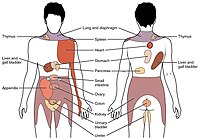
Photo from wikipedia
Abstract Background 10–30% of chronic abdominal pain originates in the abdominal wall. A common cause for chronic abdominal wall pain is the Anterior Cutaneous Nerve Entrapment Syndrome (ACNES), in which… Click to show full abstract
Abstract Background 10–30% of chronic abdominal pain originates in the abdominal wall. A common cause for chronic abdominal wall pain is the Anterior Cutaneous Nerve Entrapment Syndrome (ACNES), in which an intercostal nerve branch is entrapped in the abdominal rectus sheath. Treatment consists of local anaesthetics and neurectomy, and is ineffective in 25% of cases for yet unknown reasons. In some conditions, chronic pain is the result of altered pain processing. This so-called sensitization can manifest as segmental or even generalized hyperalgesia, and is generally difficult to treat. Objective The aim of this study was to assess pain processing in ACNES patients responsive and refractory to treatment by using Quantitative Sensory Testing, in order to explore whether signs of altered central pain processing are present in ACNES and are a possible explanation for poor treatment outcomes. Methods 50 patients treated for ACNES with locally orientated treatment were included. They were allocated to a responsive or refractory group based on their response to treatment. Patients showing an improvement of the Visual Analogue Scale (VAS) pain score combined with a current absolute VAS of <40 mm were scored as responsive. Sensation and pain thresholds to pressure and electric skin stimulation were determined in the paravertebral bilateral ACNES dermatomes and at four control areas on the non-dominant side of the body, i.e. the musculus trapezius pars medialis, musculus rectus femoris, musculus abductor hallucis and the thenar. The ACNES dermatomes were chosen to signal segmental hyperalgesia and the sum of the control areas together as a reflection of generalized hyperalgesia. Lower thresholds were interpreted as signs of sensitized pain processing. To test for alterations in endogenous pain inhibition, a conditioned pain modulation (CPM) response to a cold pressor task was determined. Also, patients filled in three pain-related questionnaires, to evaluate possible influence of psychological characteristics on the experienced pain. Results Patients refractory to treatment showed significantly lower pressure pain thresholds in the ACNES dermatomes and for the sum of as well as in two individual control areas. No differences were found between groups for electric thresholds or CPM response. Duration of complaints before diagnosis and treatment was significantly longer in the refractory compared to the responsive group, and refractory patients scored higher on the pain-related psychological surveys. Conclusion and Implications In this hypothesis-generating exploratory study, ACNES patients refractory to treatment showed more signs of sensitized segmental and central pain processing. A longer duration of complaints before diagnosis and treatment may be related to these alterations in pain processing, and both findings could be associated with less effective locally orientated treatment. In order to validate these hypotheses further research is needed. Registration number NCT01920880 (Clinical Trials Register; http://www.clinicaltrials.gov).
Journal Title: Scandinavian Journal of Pain
Year Published: 2017
Link to full text (if available)
Share on Social Media: Sign Up to like & get
recommendations!